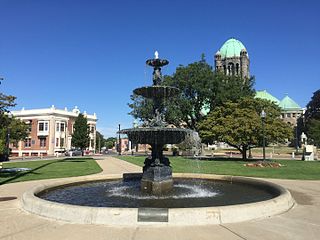
Taunton is a city in Bristol County, Massachusetts, United States. It is the seat of Bristol County. Taunton is situated on the Taunton River which winds its way through the city on its way to Mount Hope Bay, 10 miles (16 km) to the south. At the 2020 census, the city had a population of 59,408. Shaunna O'Connell is the mayor of Taunton.

Hanover is a town in Plymouth County, Massachusetts, United States. The population was 14,833 at the 2020 census.

Bridgewater is a town located in Plymouth County, in the state of Massachusetts, United States. As of the 2020 U.S. Census, the town's population was 28,633. Bridgewater is located approximately 25 miles (40 km) south of Boston and approximately 35 miles east of Providence, Rhode Island.
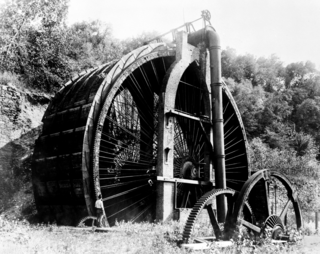
The Burden Iron Works was an iron works and industrial complex on the Hudson River and Wynantskill Creek in Troy, New York. It once housed the Burden Water Wheel, the most powerful vertical water wheel in history. It is widely believed that George Washington Gale Ferris Jr., inventor of the Ferris wheel, had occasion to observe the wheel while a student at Rensselaer Polytechnic Institute. The iron works site was listed on the National Register of Historic Places as an archaeological site in 1977. The Burden Ironworks Office Building was previously listed in 1972.

Saugus Iron Works National Historic Site is a National Historic Site about 10 miles northeast of Downtown Boston in Saugus, Massachusetts. It is the site of the first integrated ironworks in North America, founded by John Winthrop the Younger and in operation between 1646 and approximately 1670. It includes the reconstructed blast furnace, forge, rolling mill, shear, slitter and a quarter-ton trip hammer.

The Phoenix Iron Works, located in Phoenixville, Pennsylvania, was a manufacturer of iron and related products during the 19th century and early 20th century. Phoenix Iron Company was a major producer of cannon for the Union Army during the American Civil War. The company also produced the Phoenix column, an advance in construction material. Company facilities are a core component of the Phoenixville Historic District, a National Register of Historic Places site that was in 2006 recognized as a historic landmark by ASM International.

Samuel Leonard Crocker was a prominent businessman and U.S. Representative from Taunton, Massachusetts. Crocker graduated from Brown University, Providence, Rhode Island, in 1822. Throughout his life, he engaged in various manufacturing and civic interests in his hometown of Taunton and throughout Massachusetts.
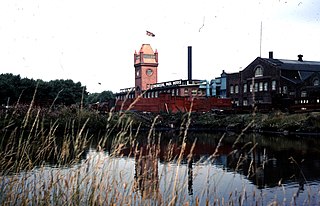
Mather & Platt is the name of several large engineering firms in Europe, South Africa and Asia that are subsidiaries of Wilo SE, Germany or were founded by former employees. The original company was founded in the Newton Heath area of Manchester, England, where it was a major employer. That firm continues as a food processing and packaging business, trading as M & P Engineering in Trafford Park, Manchester.

The Old Colony Iron Works-Nemasket Mills Complex is a historic industrial site located on Old Colony Avenue in the East Taunton section of Taunton, Massachusetts, United States, adjacent to the Taunton River at the Raynham town line. The site was first occupied by the Old Colony Iron Company, which had originally been established in the 1820s as Horatio Leonard & Company. The western part of the complex was sold to Nemasket Mills in 1889. The eastern part was acquired by the Standard Oil Cloth Company. The site was added to the National Register of Historic Places in 1984.
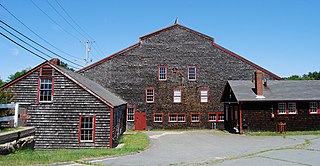
Tremont Nail Factory District is a historic district in Wareham, Massachusetts. It makes up the area occupied by the former Tremont Nail Company.

Sachem Rock Farm is a historic farm at 355 Plymouth Street in East Bridgewater, Massachusetts, United States. The farm location is important for a variety of reasons. Its earliest historical association is with the Wampanoag people, who are known to have used the area, particularly around Sachem Rock, a granite outcrop that is the property's high point, prior to European contact. Sachem Rock itself is historically significant as the site of a meeting in 1649 between English settlers from the Plymouth Colony, including Myles Standish, with the Wampanoag sachem Massasoit. In this meeting the colonists purchased rights to a large tract of land, including East and West Bridgewater, Bridgewater, and Brockton.
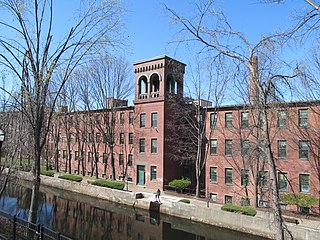
Ames Manufacturing Company was a manufacturer of swords, tools, and cutlery in Chicopee, Massachusetts, as well as an iron and bronze foundry. They were a significant provider of side arms, swords, light artillery, and heavy ordnance for the Union in the American Civil War. They also cast several bronze statues, which can be found throughout New England.

The Crompton Loom Works is an historic industrial complex of the Crompton Corporation at 132-142 Green Street in Worcester, Massachusetts. The factory manufactured looms for textile factories. With its original portion dating to 1860, the complex is one of the oldest surviving industrial sites in the city. The facility was established by George Crompton, whose father William had invented the first power loom for weaving fancy fabrics. The younger Crompton's business would become of the most significant employers in the city, and his innovative looms would revolutionize the textile industry. Crompton and his successors would operate the loom manufacturing works at Green Street well into the 1960s. The manufacturing capabilities on the site were applied to producing can packaging machines and bowling pinsetters. Capabilities at the Green Street facility included machining, drop hammer forging, a cast iron foundry, wood working. and pattern making, along with a materials testing lab.. The building has subsequently been adapted to other uses. The complex was listed on the National Register of Historic Places in 1980, and included as part of the Blackstone Canal Historic District in 1995.

The John Winthrop Jr. Iron Furnace Site is a historic archaeological site at 61 Crescent Street, Quincy, Massachusetts. The site is called Braintree Furnace in some texts; the West Quincy location at the time of operation was in a part of Braintree, Massachusetts, that later became Quincy. Its importance lies in the fact that it was the first iron blast furnace established in what would become the United States. Furnace Brook, a stream which begins on the eastern slopes of the Blue Hills and meanders for about four miles from southwest to northeast through the middle of Quincy toward Quincy Bay, was named for the works site.

War Memorial Park is a public park in West Bridgewater, Massachusetts. It is located south of the town center, bounded by River Street, Arch Street and the Town River. The park was established in the 1930s and was constructed in part with funding from the Works Progress Administration. The park is located at the site of West Bridgewater's earliest industrial activities, a mill site dating to the 17th century. This early use spawned a variety of other water-powered industrial uses in the 18th and 19th centuries, and was notably the site of Ames Shovel Company's first factory. The 1936 creation of the park resulted in the donation of a large number of historic industrial artifacts, which are displayed on its grounds.

The Tremont Nail Company was a nail manufacturing company located in Wareham, Massachusetts, from 1819 to 2006. The Tremont Nail brand was purchased by Acorn Manufacturing of Mansfield, Massachusetts, where it still produces cut nails and other products for restoration projects. They are the oldest manufacturer of steel cut nails in the United States.

Nahum Stetson was a leading businessman from southeastern Massachusetts during the 19th century. He is best known for his role in establishing the Bridgewater Iron Company as one of the largest iron works in the United States during the mid-1800s. Stetson was also involved in several other iron companies throughout the southeastern New England region, as well as other notable businesses, including banks and railroads. His grandson, Nahum Stetson (1856-1933) was part of the Steinway & Sons piano company, as part of its sales team and board of directors.

The Taunton Iron Works was located on the banks of the Forge River in what is now Raynham, Massachusetts. It was the first iron works established in Plymouth Colony, and only the third in New England. Much more successful than earlier works at Saugus, and Braintree, it operated for a remarkable period of two hundred and twenty years, from 1656 to 1876.

David Ames (colonel) (February 2, 1760 - August 6, 1847) served as first superintendent of the Springfield Armory in Springfield, Massachusetts, from 1794 to October 31, 1802. He supplied the American army with shovels and guns during the American Revolution and was commissioned in the militia. Upon completion of service at the Armory, he entered the paper-manufacturing business and by 1838 was proprietor of the most extensive paper manufacturing operation in the United States.
Joseph Jenckes Sr., also spelled Jencks and Jenks, was a bladesmith, blacksmith, mechanic, and inventor who was instrumental in establishing the Saugus Iron Works in Massachusetts Bay Colony where he was granted the first machine patent in North America.























